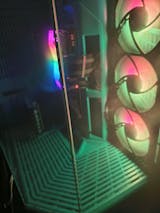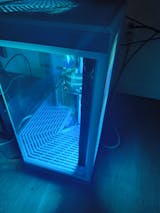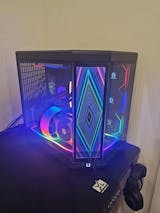Your power supply unit (PSU) might not be the most glamorous component in your setup, but it’s definitely one of the most important. A weak or outdated PSU can quietly sabotage your entire system—causing instability, limiting upgrades, or even damaging hardware. So how do you know if your PSU is holding you back?
Let’s break down some signs of a bad or failing PSU.
1. Random Shutdowns or Restarts
If your system powers off without warning during intense tasks like gaming, rendering, or multitasking, it could mean your PSU is struggling to supply consistent power. This happens when the PSU can't handle the wattage demands of your CPU, GPU, or both.
Check: Look at your system’s peak power draw and compare it to your PSU’s rated capacity. Don’t just check wattage—look at amperage on the 12V rail as well.
2. Your GPU Isn’t Performing as Expected
Installed a new graphics card but not seeing the performance boost you expected? If you're experiencing stuttering, low frame rates, or crashes—especially under load—your PSU might not be giving your GPU enough clean power to run at full potential.
Check: Use tools like MSI Afterburner to monitor GPU performance. If your GPU is underclocking itself or hitting power limits early, your PSU could be the bottleneck.
3. System Instability or BSODs (Blue Screens of Death)
Unexpected blue screens, system freezes, crashes, or even boot failures can often point to hardware or driver issues—but don’t rule out your PSU as the hidden villain behind the chaos. When your power supply is unable to deliver consistent, clean power to your components, especially under stress, it can cause your system to behave erratically.
How a PSU Can Trigger Instability
Your PSU distributes power to your CPU, GPU, RAM, storage, and motherboard. If it can’t supply enough voltage—or delivers fluctuating power—these parts may crash mid-task or corrupt data in transit. This often manifests as:
-
BSODs with vague or varying error codes
-
Crashes during gaming or high-load tasks
-
Sudden restarts without warning
-
Hangs during boot or system initialization
What to Watch For
-
Inconsistency: If your PC is totally fine during web browsing but crashes during gaming, video rendering, or stress testing, your PSU may be failing to meet higher load demands.
-
Voltage Drops: Modern motherboards can monitor 3.3V, 5V, and 12V rails. Large or sudden drops can result in instability.
-
RAM and Storage Errors: These components are sensitive to voltage quality. Unexplained memory errors or file corruption may stem from unstable power rather than faulty hardware.
-
Hard Crashes vs. Soft Freezes: A full power cut (everything turns off instantly) is more likely PSU-related than a slow freeze or app crash.
How to Diagnose
-
Monitor Voltages with Software: Use tools like HWiNFO or your motherboard’s BIOS to track voltage behavior, especially under load. Look for big deviations from the standard values (12V, 5V, 3.3V).
-
Stress Test Responsibly: Run a stress test (like OCCT or AIDA64) that includes a PSU test option. If your system crashes during it, that's a red flag.
-
Check the Event Viewer: In Windows Event Viewer, look for Kernel-Power errors or unexpected shutdowns—these often trace back to power delivery issues.
-
Try Another PSU: If all else fails and you're still getting random crashes or BSODs, testing with a known good PSU is a definitive way to identify the issue.
Common BSOD Error Codes Linked to Power Issues
-
IRQL_NOT_LESS_OR_EQUAL -
WHEA_UNCORRECTABLE_ERROR -
MEMORY_MANAGEMENT -
KERNEL_SECURITY_CHECK_FAILURE
These don’t guarantee a PSU issue, but when paired with load-related crashes, they’re worth investigating.
If your system is unstable and you’ve ruled out overheating, software bugs, and bad RAM—your PSU might be the real problem. A solid, high-efficiency PSU not only stabilizes performance but protects your components from long-term damage caused by erratic power delivery.
4. You're Planning an Upgrade
Upgrading to a newer, more powerful GPU or CPU? These components draw more power—sometimes significantly more—than your older ones. Using an underpowered PSU could limit your ability to take full advantage of them or even prevent your system from booting.
Check: Use an online PSU calculator (like OuterVision or Seasonic) to estimate your system’s required wattage, then add a 20–30% buffer for safety and future growth.
5. The PSU Is Old or Low Quality
If your PSU is over 5 years old or came bundled with a prebuilt or budget case, it may not be up to today’s efficiency or safety standards. Aging capacitors, outdated rail designs, and lower efficiency ratings can all lead to power issues.
Check: Look for certifications like 80 Plus Bronze, Gold, or better, and stick to reputable PSU brands. A Tier List (like the one from LTT or Cultists) can also help you gauge PSU quality.
6. You're Noticing Coil Whine or Electrical Noise
Coil whine is a high-pitched buzzing or squealing noise that can come from your power supply, GPU, or even the motherboard under load. While it doesn’t necessarily mean your system is in danger, it can be a sign of electrical inefficiency or stress—often caused by a struggling or lower-quality PSU.
What is Coil Whine?
Coil whine occurs when electrical current passes through the PSU's inductors (coils) and causes them to vibrate at an audible frequency. This can happen more often under heavy loads, like gaming or benchmarking, especially when frame rates spike into the hundreds (or even thousands) of FPS.
Why It Matters
-
Annoyance Factor: For many users, coil whine is just plain irritating. It’s not a danger to your hardware, but it can ruin an otherwise silent setup.
-
Indicator of PSU Stress: If the noise only happens during peak loads, it could mean your PSU is working overtime—or is being pushed to its limits.
-
Electrical Quality: Loud or persistent coil whine may suggest poor filtering or cheaper components in your PSU, especially if it came from a lower-tier brand or lacks proper certifications.
Other Electrical Noises to Watch For
-
Clicking or Ticking: These can sometimes indicate relay issues or fan problems within the PSU.
-
Buzzing or Humming: Continuous buzzing—even at idle—can hint at voltage irregularities or poor power regulation.
How to Troubleshoot Your PSU
-
Listen Closely: Identify if the sound is coming from the PSU or another component like the GPU. Sometimes GPU coil whine is mistaken for PSU issues.
-
Limit FPS: Try enabling V-Sync or setting an FPS cap to reduce the electrical load and see if the noise subsides.
-
Use a High-Quality PSU: Better PSUs use higher-grade components that are often insulated against audible vibration.
-
Test with Another PSU: If possible, swap in a known quiet, well-rated PSU to confirm the source.
⚠️ If the noise is paired with performance drops, system instability, or a burnt smell—shut down your system immediately. It may indicate a failing or dangerous PSU.
Coil whine isn't always a problem—but if it's loud, constant, or comes with system issues, your power supply unit (PSU) could be the root cause. A better-quality unit with stronger voltage regulation and cleaner power delivery can help eliminate or greatly reduce these sounds.
If your PSU is holding you back, it’s time to treat it like the core component it is. Skimping on power might save money now, but it can cost you in stability, performance, and long-term component health. When in doubt, overestimate your needs slightly and invest in quality—you’ll be glad you did.
Quick Rule of Thumb:
If your PC has grown in power or complexity, but your power supply unit (PSU) hasn't kept up—it’s probably time for an upgrade. 💡
















